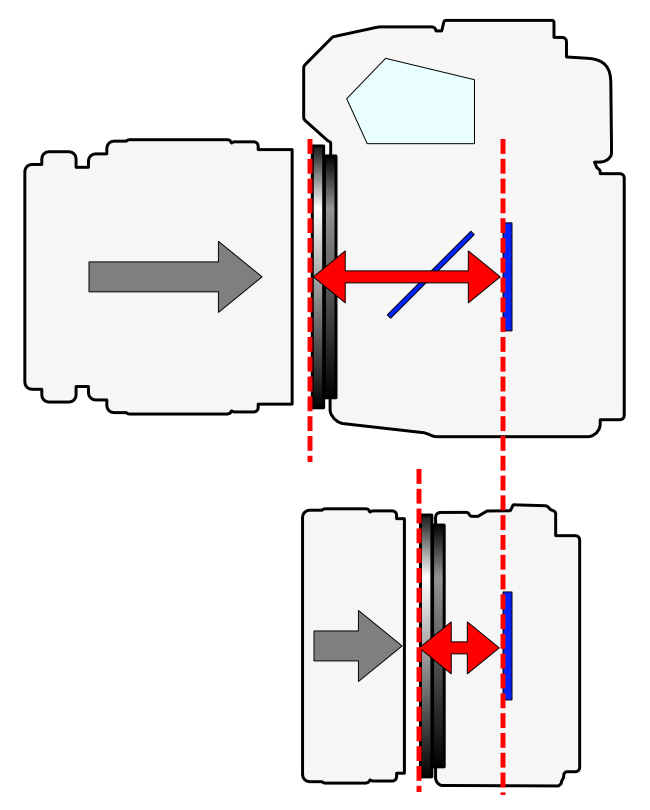Flange Distance or Flange Focal Distance is the distance between the flange (the lens mount) and the sensor.
Most lens we use today is a combination of multiple optical / glass elements. And we obtain focus by moving these elements inside the lens. In most cases, the element or element group at the end of the lens moves while focusing. The closer it gets to the sensor, the far we can focus. And the further it gets from the sensor, the closer we can focus. The flange / lens mount affects this distance with the lens / back of the lens with the sensor affecting where we can focus.
If the flange distance is properly maintained between a lens and the sensor, we would be able to focus from the closest focus distance to infinity without any issue. If we change this distance, it can affect focusing. For example, if we move a lens a little far from sensor we would be able to focus on closer subjects. But we will no longer be able to focus on infinity.
Macro extension tubes use this technique to focus on closer subjects. They increase the distance between the lens and sensor. That lets any lens to behave like a macro lens at the expense of no longer being able to focus on infinity. On the other hand, if the lens is put a bit closer compared to the flange distance, we will have a reverse effect and would be able to focus past infinity but won’t be able to focus on closer subjects.

Flange Distance and Adapters
Different camera systems have different flange distance. For example, the flange distance for Canon’s EF mount is 44mm. The flange focal distance for EF-S lens is 26mm, EF-M is 18mm and RF is 20mm.
Now let’s think about it, if a lens mount needs more distance from the sensor than we have right now, we can put it further by using something in the middle, right? EF-M lens mount has only 18mm distance from the sensor, so what if we want to mount a EF lens with 44mm flange distance?
We just add an empty tube to make up for that distance. Put an adapter that places the EF lens 26mm further from the EF-M lens mount, making it a total 44mm and your EF lens works fine on a EF-M mount.
What about EF-S? How does EF lenses work on EF-S without such adapters although EF has longer flange distance? There’s a tricky part here. The EF and EF-S mounts are the same. But the EF-S lenses protrude from the lens mount inside. So you mount the EF-S lens as if you were mounting it on a EF mount, 44mm far away from the sensor but the EF-S lens extends inward, so the end of the lens is actually 26mm far from the sensor, not 44mm, exactly matching the required flange distance.
However, because of this protrusion, you can’t use a EF-S lens on EF mounts, because this extended part would harm the mirror / sensor inside. But for EF-M mounts, this is not an issue. Normal EF to EF-M adapters have around 26mm gap. EF-S lenses can protrude just fine in the available extra space there unless there are more optical elements (ie. Speed boosters) inside that adapter.
In a very similar fashion, because of the larger flange focal distance, we can mount EF and EF-S lenses on RF mounts with appropriate adapters. But we can’t mount EF-M lenses on RF mounts.
The answer to the question – “Can X mount lenses be adapted to Y mount system?” lies in the respective flange distances. If X has a longer flange distance than Y, then X can be adapted to Y – we just need an empty tube to make up for the difference. If X doesn’t have a longer flange distance, it’s not possible. This is why we can adapt Canon EF lenses (44mm flange distance) to Sony E mounts (18mm flange distance) but not the other way around. This is also why we can’t have EF to EF speed boosters – because there’s simply no space available to put some optical elements.
But with these mathematical revelations, you may ask, “hey, why can’t we mount RF on EF-M?”. That is technically, theoretically possible as the RF mount flange distance is 2mm longer. But that’s kind of too tight of a space to work within, no? I guess that’s why there’s no such adapters available.
Pingback: Lens Buying Guide - Masnun | Photography